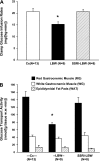Treatment with an SSRI antidepressant restores hippocampo-hypothalamic corticosteroid feedback and reverses insulin resistance in low-birth-weight rats
- PMID: 20103738
- PMCID: PMC2867376
- DOI: 10.1152/ajpendo.00606.2009
Treatment with an SSRI antidepressant restores hippocampo-hypothalamic corticosteroid feedback and reverses insulin resistance in low-birth-weight rats
Abstract
Low birth weight (LBW) is associated with type 2 diabetes and depression, which may be related to prenatal stress and insulin resistance as a result of chronic hypothalamic-pituitary-adrenal (HPA) axis hyperactivity. We examined whether treatment with a selective serotonin reuptake inhibitor [escitalopram (ESC)] could downregulate HPA axis activity and restore insulin sensitivity in LBW rats. After 4-5 wk of treatment, ESC-exposed LBW (SSRI-LBW) and saline-treated control and LBW rats (Cx and LBW) underwent an oral glucose tolerance test or a hyperinsulinemic euglycemic clamp to assess whole body insulin sensitivity. Hepatic phosphoenolpyruvate carboxykinase (PEPCK) mRNA expression and red skeletal muscle PKB Ser(473) phosphorylation were used to assess tissue-specific insulin sensitivity. mRNA expression of the hypothalamic mineralocorticoid receptor was fivefold upregulated in LBW (P < 0.05 vs. Cx), accompanied by increased corticosterone release during restraint stress and total 24-h urinary excretion (P < 0.05 vs. Cx), whole body insulin resistance (P < 0.001 vs. Cx), and impaired insulin suppression of hepatic PEPCK mRNA expression (P < 0.05 vs. Cx). Additionally, there was a tendency for reduced red muscle PKB Ser(473) phosphorylation. The ESC treatment normalized corticosterone secretion (P < 0.05 vs. LBW), whole body insulin sensitivity (P < 0.01) as well as postprandial suppression of hepatic mRNA PEPCK expression (P < 0.05), and red muscle PKB Ser(473) phosphorylation (P < 0.01 vs. LBW). We conclude that these data suggest that the insulin resistance and chronic HPA axis hyperactivity in LBW rats can be reversed by treatment with an ESC, which downregulates HPA axis activity, lowers glucocorticoid exposure, and restores insulin sensitivity in LBW rats.
Figures



Similar articles
-
Increased hypothalamic-pituitary-adrenal axis activity and hepatic insulin resistance in low-birth-weight rats.Am J Physiol Endocrinol Metab. 2007 Nov;293(5):E1451-8. doi: 10.1152/ajpendo.00356.2007. Epub 2007 Sep 25. Am J Physiol Endocrinol Metab. 2007. PMID: 17895287 Free PMC article.
-
Long-term adaptations in glucocorticoid receptor and mineralocorticoid receptor mRNA and negative feedback on the hypothalamo-pituitary-adrenal axis following neonatal maternal separation.Biol Psychiatry. 2004 Feb 15;55(4):367-75. doi: 10.1016/j.biopsych.2003.10.007. Biol Psychiatry. 2004. PMID: 14960289
-
Prenatal exposure to dexamethasone alters hippocampal drive on hypothalamic-pituitary-adrenal axis activity in adult male rats.Am J Physiol Regul Integr Comp Physiol. 2006 May;290(5):R1366-73. doi: 10.1152/ajpregu.00757.2004. Epub 2006 Jan 5. Am J Physiol Regul Integr Comp Physiol. 2006. PMID: 16397092
-
Acute glucocorticoid pretreatment suppresses stress-induced hypothalamic-pituitary-adrenal axis hormone secretion and expression of corticotropin-releasing hormone hnRNA but does not affect c-fos mRNA or fos protein expression in the paraventricular nucleus of the hypothalamus.J Neuroendocrinol. 2003 Nov;15(11):1075-83. doi: 10.1046/j.1365-2826.2003.01100.x. J Neuroendocrinol. 2003. PMID: 14622438
-
The effects of antidepressants on the hypothalamic-pituitary-adrenal axis.Drug News Perspect. 2006 Dec;19(10):603-8. doi: 10.1358/dnp.2006.19.10.1068007. Drug News Perspect. 2006. PMID: 17299602 Review.
Cited by
-
A review of the association between depression and insulin resistance: pitfalls of secondary analyses or a promising new approach to prevention of type 2 diabetes?Curr Psychiatry Rep. 2012 Feb;14(1):8-14. doi: 10.1007/s11920-011-0245-8. Curr Psychiatry Rep. 2012. PMID: 22094982 Review.
-
Excessive corticosterone induces excitotoxicity of hippocampal neurons and sensitivity of potassium channels via insulin-signaling pathway.Metab Brain Dis. 2019 Feb;34(1):119-128. doi: 10.1007/s11011-018-0326-z. Epub 2018 Oct 4. Metab Brain Dis. 2019. PMID: 30284676
-
Brain and behavioral correlates of insulin resistance in youth with depression and obesity.Horm Behav. 2019 Feb;108:73-83. doi: 10.1016/j.yhbeh.2018.03.009. Epub 2018 Apr 23. Horm Behav. 2019. PMID: 29596854 Free PMC article. Clinical Trial.
-
Pre- and early-postnatal nutrition modify gene and protein expressions of muscle energy metabolism markers and phospholipid Fatty Acid composition in a muscle type specific manner in sheep.PLoS One. 2013 Jun 6;8(6):e65452. doi: 10.1371/journal.pone.0065452. Print 2013. PLoS One. 2013. PMID: 23755234 Free PMC article.
-
Antidepressants and type 2 diabetes: highways to knowns and unknowns.Diabetol Metab Syndr. 2023 Aug 31;15(1):179. doi: 10.1186/s13098-023-01149-z. Diabetol Metab Syndr. 2023. PMID: 37653558 Free PMC article. Review.
References
-
- Andersen CL, Jensen JL, Orntoft TF. Normalization of real-time quantitative reverse transcription-PCR data: a model-based variance estimation approach to identify genes suited for normalization, applied to bladder and colon cancer data sets. Cancer Res 64: 5245–5250, 2004 - PubMed
-
- Andrews RC, Herlihy O, Livingstone DE, Andrew R, Walker BR. Abnormal cortisol metabolism and tissue sensitivity to cortisol in patients with glucose intolerance. J Clin Endocrinol Metab 87: 5587–5593, 2002 - PubMed
-
- Atkinson HC, Wood SA, Castrique ES, Kershaw YM, Wiles CC, Lightman SL. Corticosteroids mediate fast feedback of the rat hypothalamic-pituitary-adrenal axis via the mineralocorticoid receptor. Am J Physiol Endocrinol Metab 294: E1011–E1022, 2008 - PubMed
Publication types
MeSH terms
Substances
Grants and funding
LinkOut - more resources
Full Text Sources
Medical
Miscellaneous

